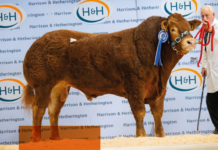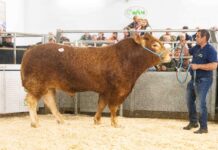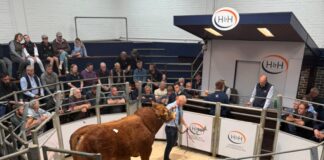Upper Coton Farms, situated on the edge of the Northamptonshire village of Guilsborough, finishes some 900-head of Limousin-cross stock each year with the marketability of the Limousin breed at the core of this finishing unit.
Run by Mike & Jane Wills together with their son Charlie (25) and part-time farm worker Paul Wilford, the aim is to firmly add value since all animals are bought in as stores from a variety of markets up and down the country including Brecon, Knighton, Bishops Castle, Carlisle, Cockermouth and Lockerbie. Their other son David (23), who is working and studying accountancy in Bristol, comes back some weekends to help out with clipping and other duties.
Nearly every animal purchased is Limousin-cross, mostly three-quarters or seven-eights, with some pure Lims in the mix as well as the odd Charolais or Blue-cross.
Limousin is the true butcher’s beast, small boned with good conformation
“I do all the buying myself and look at conformation first and foremost and try to go back as much as possible to the same breeders whose animals have gone on and done well for us,” says Mike “such as JA Wood, Kinnerton Farm, Ratlinghope, Shropshire who sell at Bishops Castle.” 80% are steers with the rest heifers which are generally harder to find as they tend to retained as breeding replacements. “You can’t beat the Lim – it’s the true butcher’s beast. They grow well, are small boned with good conformation.”
The farm comprises 600 acres in all of which 500 are owned and 100 rented, and has been in Jane’s family for three generations. Mike is originally from Liskeard in Cornwall and settled in the area in the mid-1980s. The land has an ironstone base and is pretty free draining.
100 acres are put down to maize with the rest split roughly between barley, wheat and oilseed rape. The rape is sold as a cash crop and there’s virtually no grassland. Overall, the family combines around 1000 acres, which includes some contracting for neighbouring farms. Maize has only be grown the last two years and was put in more by chance than design, admits Mike, being sown during that very wet year when half the winter oilseed rape crop failed. The family get contractors in to do the maize which helps keep the fixed costs of additional machinery down.
Says Mike, “Stores are bought-in aged 8-12 months and we try to produce as much of the feed as we can here on the farm, buying in brewers grains, pot ale syrup, minerals, sugar beet nuts and oilseed rape meal which are mixed with home-grown maize silage, straw, barley and wheat.”
Both the ration and gain are costed and performance-wise the Limousin is very cost-effective
Mike adds that he is a strong advocate of ‘Born, Bred and Fed British’ to back British farming and produce excellent quality meat for the table. Nutrition is overseen in-house and the feed is mixed on-site with a Keenan feeder which is fed twice a day.
Son Charlie studied Nutrition at Harper Adams and is responsible for the dietary side. “We feed a growing and also a finishing ration. The growing is 11.6% ME (metabolic energy) and 20% starch with the finisher 12.2% ME and 35% starch, both with 15% crude protein. A consistent ration helps rumen function, digestion and most importantly means good food conversion efficiency to deliver the best results. I’m not saying that we ignore the cost of the feed exactly but the important thing is the overall gain that the Limousin gives us. Both the ration and gain are costed and performance-wise the Limousin is very cost-effective,” says Charlie.
Newark 16th July 2014 : 28 steers average 209.69ppkg or £1,300
Mike was selling deadweight (through ABP) for a while but is back selling liveweight (at Newark) where he often finds his stock near the top of the market. Despite beef prices being down of late, at Newark on 16th July he sold Limousin steers to 223.5p (twice) to gross £1,278.42 (572kg) and £1247.13 (558kg) respectively with 28 steers in all averaging 209.69p or £1,300 compared to the market average on the day of 193.04p. The heaviest steer at 705kg sold to £1,491.08 and Upper Coton Farms had a very creditable 12 animals in the top 20 overall pence per kilo prices.
Marketable Limousin
“Limousin batches give us a consistent return. We get a few Es and Rs but most are U grades,” comments Mike, “and this is what the trade in general and our regular customers in particular are after when they buy our stock. The Limousin is very marketable; it’s small boned and all meat.”
Adds Newark Auctioneer, Paul Gentry: “Upper Coton Farms buy what the market wants in terms of very nice, well-bred types and they feed their cattle very well. They are finished to perfection, are full of meat, not too big and very well presented.”
In what are not easy times economically for finishers who are bound to the past store trade, the growth and yield of the Limousin together with meat-to-bone ratio, tremendous tops and consistent fat cover ticks all the boxes for buyers.
Another batch of 20 steers and 5 heifers is ready to go to Newark in the coming weeks (early August). See table below (Fig 1). They average 15 months of age, have spent on average 238 days on farm (DOF) with a mean weight of 640kg and a daily liveweight gain (DLWG) during total time on farm of 1.33kg. Among them are commercially-produced Limousins and Lim-crosses from pedigree herds such as Gwernfach, Glencross, Rhiwllech, Pencwm, Duncrahill, Honister and Cawfields.
| Breed | Sex | Age (M) | DOF | Weight | DLWG |
| Lim | S | 20 | 285 | 650.0 | 1.13 |
| Lim | S | 15 | 251 | 588.0 | 1.17 |
| Lim | S | 16 | 251 | 600.0 | 1.19 |
| Lim-x | S | 16 | 251 | 628.0 | 1.24 |
| Lim-x | S | 14 | 251 | 628.0 | 1.24 |
| Lim-x | S | 15 | 251 | 652.0 | 1.39 |
| Lim-x | S | 15 | 124 | 634.0 | 1.27 |
| Lim-x | S | 14 | 124 | 594.0 | 1.43 |
| Lim-x | S | 14 | 124 | 598.0 | 1.59 |
| Lim | S | 16 | 124 | 642.0 | 1.68 |
| Lim-x | S | 14 | 124 | 676.0 | 1.80 |
| Lim-x | S | 17 | 270 | 626.0 | 1.25 |
| Lim-x | S | 15 | 280 | 658.0 | 1.31 |
| Lim-x | S | 16 | 280 | 720.0 | 1.41 |
| Lim-x | S | 16 | 280 | 696.0 | 1.43 |
| Lim-x | S | 15 | 280 | 677.0 | 1.43 |
| Ba-x | S | 17 | 280 | 736.0 | 1.44 |
| Lim-x | S | 16 | 280 | 720.0 | 1.44 |
| Lim-x | S | 16 | 280 | 704.0 | 1.47 |
| Lim-x | S | 15 | 270 | 730.0 | 1.57 |
| Lim-x | H | 16 | 260 | 562.0 | 0.87 |
| Brb-x | H | 14 | 251 | 526.0 | 1.05 |
| Lim-x | H | 15 | 259 | 582.0 | 1.14 |
| Lim-x | H | 15 | 259 | 560.0 | 1.18 |
| Lim-x | H | 14 | 259 | 620.0 | 1.20 |
| AVERAGE | 15 | 238 | 640.3 | 1.33 |
Figure 1. 25 finished animals ready for market early August
Limousin advantage in per kilo gain
Keeping up the Newark Market connection, Doug and Rachel Gascoine, who trade as Gascoine Group Ltd, which runs Newark Livestock Market, also own Rudda Farm near Scarborough in North Yorkshire and the Wills Family finishes batches of pure commercial bulls on a B&B basis on their behalf. Bulls from the most recent batches have done up to 2.49kg per day with an average of 1.8kg for 34 head (see table below Fig 2). The advantage the Limousin brings with it is a better return in terms of per kilo gain set against feed costs.
|
Breed |
Age (months) |
DOF |
Weight (kg) |
DLWG |
|
LIM |
13 |
132 |
644 |
1.68 |
|
LIM |
13 |
132 |
676 |
1.72 |
|
LIM |
13 |
132 |
676 |
1.86 |
|
LIM |
13 |
132 |
654 |
1.89 |
|
LIM |
13 |
132 |
660 |
1.89 |
|
LIM |
14 |
132 |
656 |
1.93 |
|
LIM |
14 |
132 |
672 |
1.96 |
|
LIM |
13 |
132 |
626 |
1.96 |
|
LIM |
13 |
132 |
706 |
2 |
|
LIMX |
14 |
132 |
696 |
2.04 |
|
LIM |
13 |
132 |
742 |
2.49 |
|
LIM |
13 |
139 |
576 |
1.34 |
|
LIM |
13 |
139 |
560 |
1.47 |
|
LIM |
14 |
139 |
660 |
1.69 |
|
LIM |
14 |
139 |
676 |
1.84 |
|
LIM |
13 |
139 |
630 |
1.91 |
|
LIM |
13 |
139 |
662 |
1.94 |
|
LIM |
14 |
139 |
664 |
2.06 |
|
LIM |
12 |
139 |
646 |
2.22 |
|
LIM |
14 |
153 |
532 |
0.68 |
|
LIM |
14 |
153 |
640 |
1.33 |
|
LIM |
14 |
153 |
598 |
1.45 |
|
LIM |
15 |
153 |
642 |
1.46 |
|
LIM |
14 |
153 |
622 |
1.54 |
|
LIM |
14 |
153 |
612 |
1.71 |
|
LIM |
14 |
153 |
674 |
1.77 |
|
LIM |
14 |
153 |
628 |
1.79 |
|
LIMX |
15 |
153 |
668 |
1.87 |
|
LIM |
13 |
153 |
658 |
1.87 |
|
LIM |
14 |
153 |
600 |
1.88 |
|
LIM |
13 |
153 |
622 |
1.88 |
|
LIM |
14 |
153 |
648 |
1.9 |
|
SAX |
15 |
153 |
708 |
2.13 |
|
LIM |
15 |
153 |
670 |
2.15 |
|
AVERAGE |
14 |
143 |
647.2 |
1.8 |
Quiet temperament
Animal health and welfare is also a key component on the farm. Bought-in stock is allowed to settle down and after about a fortnight is vaccinated with Rispoval 4. Says Mike: “We straw up the pens every other day, never having to clip the bellies, and always walk through the stock twice a day. We handle the stock enough but not too much, preferring to combine jobs like weighing or clipping and worming in winter (with Closamectin) at the same time through the squeeze crush to make life as efficient and easy as possible for man and beast. As for temperament, we hardly ever come across a wild one and all our animals are very quiet.”



















